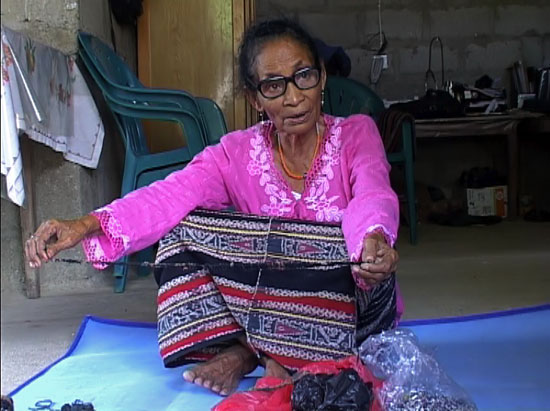For weavers like Sisilia Sii, the art of textile-making is far more than a simple pastime ““ it’s an art form tightly woven in tradition. Weaving has been an intricate part of Sii’s life in Flores, Indonesia, ever since her mother began teaching her the technique when she was a child.
Sii is among the weavers and batik makers featured in the UCLA Fowler Museum’s current exhibition “Weavers’ Stories From Island Southeast Asia,” which focuses on traditional cloth and the women behind the looms. The show runs concurrently with “Nini Towok’s Spinning Wheel: Cloth and the Cycle of Life in Kerek, Java,” which features work from the community of Kerek, the last region of Java, Indonesia, where batik is made using traditional handwoven cotton cloth.
Both exhibitions will be displayed through Dec. 5.
“In the communities where the textiles are produced, the women who make them are very well-known. It’s in fact the main measure of a woman’s status in the community ““ her skill at textile-making,” said Roy Hamilton, senior curator of the Fowler Museum’s Asian and Pacific Collections.
According to Hamilton, even though these artists are renowned in their communities, their names are commonly omitted from museum textile exhibitions. With their names forgotten by collectors, their work is attributed to their culture at large, rather than the individual artists.
“”˜Weavers’ Stories’ is really wonderful because Roy (Hamilton) makes an attempt to attach the person who made the object to the textile itself,” said Lily Doan, a conservation of archeological and ethnographic materials graduate student through a partnership with the Getty Institute who also assisted in both textile exhibitions’ displays.
Unlike typical museum displays, “Weavers’ Stories” offers an intimate opportunity to engage with the artists behind the work. Viewers are shown the weavers’ homes through a series of eight short films, each showcasing different communities in Indonesia, Malaysia, the Philippines and East Timor.
“This whole project was designed so that weavers could have a voice and could speak directly to the museum-goers. That’s why it’s primarily a video installation,” Hamilton said. “(It’s) a chance for the weavers to talk directly about their concerns and their lives ““ what motivates them, how they continue doing what they do in the face of extreme social and economic change.”
One of the weavers is Luisa de Jesus from Tutuala, Timor Leste. In her video, de Jesus recalls tragic memories of war with the Philippines and also of a cloth pattern her ancestors designed after snakeskin believed to also harbor the snake’s spirit. According to de Jesus, the cloth is worn only for special ceremonies and is highly dangerous or “hot” to those who cause trouble. After one of her snake-inspired cloths was stolen from her sister’s home amid military fighting, de Jesus believes the snake spirit was the cause for the subsequent destruction of the coconut trees.
Meanwhile, weaver Dapong anak Sempurai of Sarawak, Malaysia, reflects on the changing social structure and reduction of weavers in the community as many work in nearby cities.
“It’s very interesting that in most of the videos … it’s the women telling their own stories in their native languages,” said Agnes Stauber, Fowler Museum digital media analyst. “We didn’t “˜dub’ what they’re saying, and you really hear their voices and how they feel about these stories.”
Stauber edited the extensive collection of footage with Hamilton’s translation assistance for about six months before the interviews were completed.
“Even though I don’t understand what they’re saying, the native languages, it’s nice to hear their voices and hear how they talk about their life stories,” Stauber said. “In our culture, I have a feeling that a lot of objects we’re surrounded by today don’t have these kinds of meanings to us. It’s such a great revelation to hear these women talk about the meanings of the textiles.”
Since 1919
